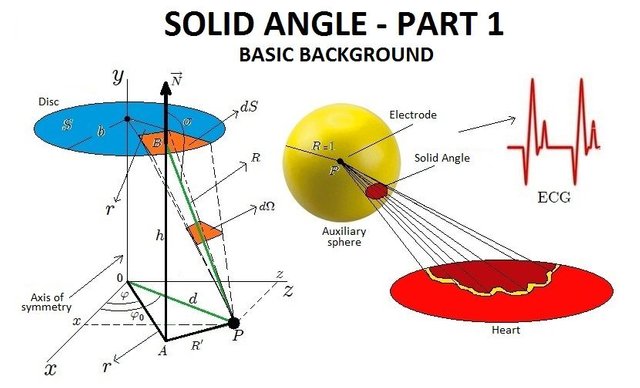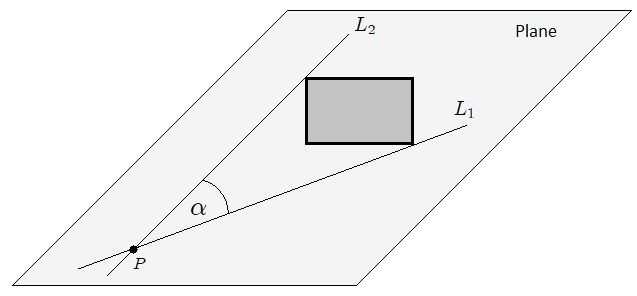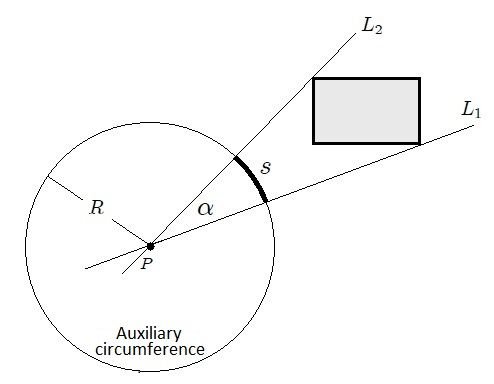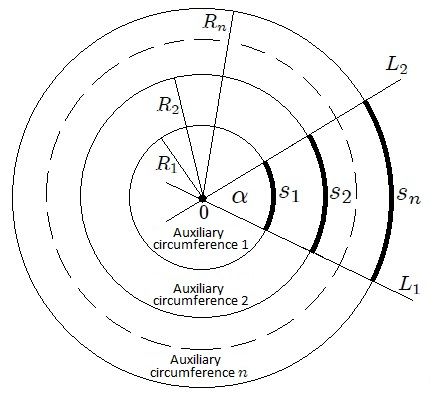THE SOLID ANGLE - PART 1 - BASIC BACKGROUND
Regards Steemians!. The present is the first of a series of posts dedicated to showing, in a clear and simple way, the definition of SOLID ANGLE, presenting the necessary equations and mathematical definitions.

BASIC BACKGROUND
THE PLANE ANGLE
| A plane angle α is a measure of the aperture between two lines intersecting at a point. |
|---|

- A circumference is superimposed on the lines L₁ and L₂, which is usually called Auxiliary Circumference, whose center coincides with point P as shown in Figure 2.

Figure 2 - Measurement of the plane angle α subtended by a plane figure with respect to a point P. - We proceed to measure the length s and the radius R of the arc that is limited by the two straight lines.
- The measure of the angle α subtended by the two lines will be given by,

Equation 1
The portions of the line that limit the angle are called sides of the angle and the point of intersection P is called the vertex.
If an auxiliary circumference of radius R₁is plotted with center at the vertex of the angle α shown in Figure 3, an arc of length s₁ is obtained so that the quotient  results in the measure of α, as indicated by the equation 1. If a new auxiliary circumference of radius R₂ (with center at its vertex) is drawn for the same angle, an arc of length s₂ is obtained, giving the quotient
results in the measure of α, as indicated by the equation 1. If a new auxiliary circumference of radius R₂ (with center at its vertex) is drawn for the same angle, an arc of length s₂ is obtained, giving the quotient  the same measure α and so on. Hence,
the same measure α and so on. Hence,


| Whatever the size of the auxiliary circumference, equation 2 will remain constant for the same aperture between the lines. |
|---|
The angle α as defined in equation 1 is dimensionless, since it is the quotient between two lengths. However, it would be somewhat inconvenient to measure angles in this way, so the International System of Units uses the Radian as an unit of plane angle. Radian is denoted by rad.


| "Radian is a special name given to number 1, which can be used to provide information about the quantity it qualifies in. In practice, the rad symbol is used when convenient, but the symbol of the derivative unit 1 is often omitted when specifying values of dimensionless quantities ". |
|---|
REFERENCES
- Soldovieri, Terenzio & Viloria, Tony. EL ANGULO SOLIDO Y ALGUNAS DE SUS APLICACIONES. 1era edición (borrador). You can download it on my website http://www.cmc.org.ve/tsweb/
- All the images presented here were elaborated by me. The color image constitutes the cover image of the text indicated above, of which i'm the author.
- Real Academia Española. http://www.rae.es/ Diccionario de la Lengua Española. Electronic version that allows access to the content of the 22nd. edition and the amendments incorporated until 2012.
- Faget, J. & Mazzaschi, J. TEMAS PROGRAMADOS DE FISICA - GENERALIDADES, volumen 1. Editorial Reverté, S.A., 1976.
- Alvarez C., E. ELEMENTOS DE GEOMETRIA, CON NUMEROSOS EJERCICIOS Y GEOMETRIA
DEL COMPAS. Editorial Universidad de Medellín, 2003.

It is my wish that the present information can be very useful to all. Remember that the present is the first of a series of posts written with the final objective of presenting in a clear and simple way the definition of SOLID ANGLE. The next in this series will refer to the definition of the Diedro Angle, the Polyhedron Angle and to the intersection of a polyhedron angle with a sphere.
Sorry for my English!.
Until my next post. Regards! 😁


Excellent post brother @tsoldovieri, with very good presentation. Thank you for filling steemit with quality information. Greets and a hug!
Thanks my perijanero friend @hugobohor !. Greets and a hug!.